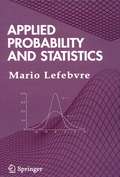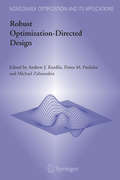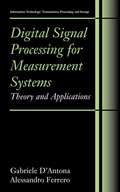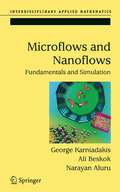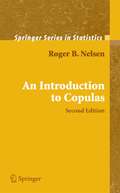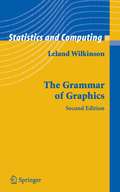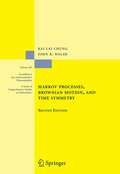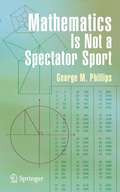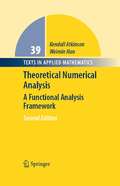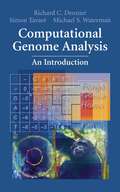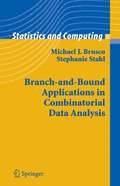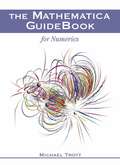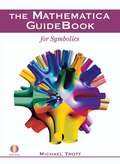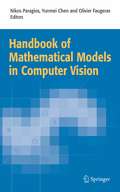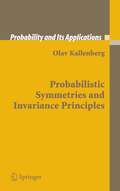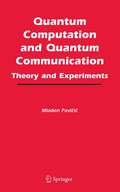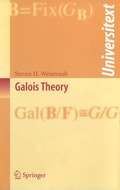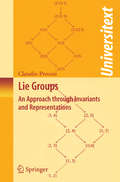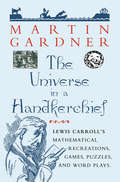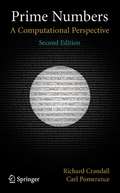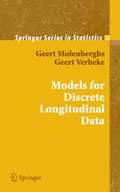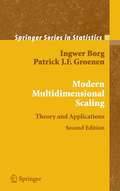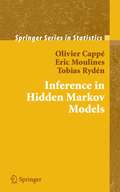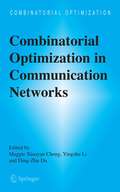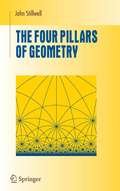- Table View
- List View
Applied Probability and Statistics
by Mario LefebvreThis book moves systematically through the topic of applied probability from an introductory chapter to such topics as random variables and vectors, stochastic processes, estimation, testing and regression. The topics are well chosen and the presentation is enriched by many examples from real life. Each chapter concludes with many original, solved and unsolved problems and hundreds of multiple choice questions, enabling those unfamiliar with the topics to master them. Additionally appealing are historical notes on the mathematicians mentioned throughout, and a useful bibliography. A distinguishing character of the book is its thorough and succinct handling of the varied topics.
Robust Optimization-Directed Design (Nonconvex Optimization and Its Applications #81)
by Andrew J. Kurdila Panos M. Pardalos Michael ZabarankinRobust design—that is, managing design uncertainties such as model uncertainty or parametric uncertainty—is the often unpleasant issue crucial in much multidisciplinary optimal design work. Recently, there has been enormous practical interest in strategies for applying optimization tools to the development of robust solutions and designs in several areas, including aerodynamics, the integration of sensing (e.g., laser radars, vision-based systems, and millimeter-wave radars) and control, cooperative control with poorly modeled uncertainty, cascading failures in military and civilian applications, multi-mode seekers/sensor fusion, and data association problems and tracking systems. The contributions to this book explore these different strategies. The expression "optimization-directed” in this book’s title is meant to suggest that the focus is not agonizing over whether optimization strategies identify a true global optimum, but rather whether these strategies make significant design improvements.
Digital Signal Processing for Measurement Systems: Theory and Applications (Information Technology: Transmission, Processing and Storage)
by Gabriele D'Antona Alessandro FerreroThis excellent Senior undergraduate/graduate textbook offers an unprecedented measurement of science perspective on DSP theory and applications, a wealth of definitions and real-life examples making it invaluable for students, while practical.
Microflows and Nanoflows: Fundamentals and Simulation (Interdisciplinary Applied Mathematics #29)
by George Karniadakis Ali Beskok Narayan AluruSubject area has witnessed explosive growth during the last decade and the technology is progressing at an astronomical rate. Previous edition was first to focus exclusively on flow physics within microdevices. It sold over 900 copies in North America since 11/01. New edition is 40 percent longer, with four new chapters on recent topics including Nanofluidics.
An Introduction to Copulas (Springer Series in Statistics)
by Roger B. NelsenThe study of copulas and their role in statistics is a new but vigorously growing field. In this book the student or practitioner of statistics and probability will find discussions of the fundamental properties of copulas and some of their primary applications. The applications include the study of dependence and measures of association, and the construction of families of bivariate distributions. This book is suitable as a text or for self-study.
The Grammar of Graphics (Statistics and Computing)
by Leland WilkinsonPresents a unique foundation for producing almost every quantitative graphic found in scientific journals, newspapers, statistical packages, and data visualization systems The new edition features six new chapters and has undergone substantial revision. The first edition has sold more than 2200 copies. Four color throughout.
Markov Processes, Brownian Motion, and Time Symmetry (Grundlehren der mathematischen Wissenschaften #249)
by Kai Lai Chung John B. WalshFrom the reviews of the First Edition: "This excellent book is based on several sets of lecture notes written over a decade and has its origin in a one-semester course given by the author at the ETH, Zürich, in the spring of 1970. The author's aim was to present some of the best features of Markov processes and, in particular, of Brownian motion with a minimum of prerequisites and technicalities. The reader who becomes acquainted with the volume cannot but agree with the reviewer that the author was very successful in accomplishing this goal…The volume is very useful for people who wish to learn Markov processes but it seems to the reviewer that it is also of great interest to specialists in this area who could derive much stimulus from it. One can be convinced that it will receive wide circulation." (Mathematical Reviews) This new edition contains 9 new chapters which include new exercises, references, and multiple corrections throughout the original text.
Mathematics Is Not a Spectator Sport
by George PhillipsCompared to other popular math books, there is more algebraic manipulation, and more applications of algebra in number theory and geometry Presents an exciting variety of topics to motivate beginning students May be used as an introductory course or as background reading
Theoretical Numerical Analysis: A Functional Analysis Framework (Texts in Applied Mathematics #39)
by Kendall Atkinson Weimin HanMathematics is playing an ever more important role in the physical and biological sciences, provoking a blurring of boundaries between scienti?c disciplines and a resurgence of interest in the modern as well as the cl- sical techniques of applied mathematics. This renewal of interest, both in research and teaching, has led to the establishment of the series: Texts in Applied Mathematics (TAM). Thedevelopmentofnewcoursesisanaturalconsequenceofahighlevelof excitement on the research frontier as newer techniques, such as numerical and symbolic computer systems, dynamical systems, and chaos, mix with and reinforce the traditional methods of applied mathematics. Thus, the purpose of this textbook series is to meet the current and future needs of these advances and to encourage the teaching of new courses. TAM will publish textbooks suitable for use in advanced undergraduate and beginning graduate courses, and will complement the Applied Ma- ematical Sciences (AMS) series, which will focus on advanced textbooks and research-level monographs.
Computational Genome Analysis: An Introduction
by Richard C. Deonier Simon Tavaré Michael S. WatermanThis book presents the foundations of key problems in computational molecular biology and bioinformatics. It focuses on computational and statistical principles applied to genomes, and introduces the mathematics and statistics that are crucial for understanding these applications. The book features a free download of the R software statistics package and the text provides great crossover material that is interesting and accessible to students in biology, mathematics, statistics and computer science. More than 100 illustrations and diagrams reinforce concepts and present key results from the primary literature. Exercises are given at the end of chapters.
Branch-and-Bound Applications in Combinatorial Data Analysis (Statistics and Computing)
by Michael J. Brusco Stephanie StahlThis book provides clear explanatory text, illustrative mathematics and algorithms, demonstrations of the iterative process, pseudocode, and well-developed examples for applications of the branch-and-bound paradigm to important problems in combinatorial data analysis. Supplementary material, such as computer programs, are provided on the world wide web. Dr. Brusco is an editorial board member for the Journal of Classification, and a member of the Board of Directors for the Classification Society of North America.
The Mathematica GuideBook for Numerics
by Michael TrottProvides the reader with working knowledge of Mathematica and key aspects of Mathematica's numerical capabilities needed to deal with virtually any "real life" problem Clear organization, complete topic coverage, and an accessible writing style for both novices and experts Website for book with additional materials: http://www.MathematicaGuideBooks.org Accompanying DVD containing all materials as an electronic book with complete, executable Mathematica 5.1 compatible code and programs, rendered color graphics, and animations
The Mathematica GuideBook for Symbolics
by Michael TrottProvides reader with working knowledge of Mathematica and key aspects of Mathematica symbolic capabilities, the real heart of Mathematica and the ingredient of the Mathematica software system that makes it so unique and powerful Clear organization, complete topic coverage, and an accessible writing style for both novices and experts Website for book with additional materials: http://www/MathematicaGuideBooks.org Accompanying DVD containing all materials as an electronic book with complete, executable Mathematica 5.1 compatible code and programs, rendered color graphics, and animations
Handbook of Mathematical Models in Computer Vision
by Nikos Paragios Yunmei Chen Olivier D. FaugerasAbstract Biological vision is a rather fascinating domain of research. Scientists of various origins like biology, medicine, neurophysiology, engineering, math ematics, etc. aim to understand the processes leading to visual perception process and at reproducing such systems. Understanding the environment is most of the time done through visual perception which appears to be one of the most fundamental sensory abilities in humans and therefore a significant amount of research effort has been dedicated towards modelling and repro ducing human visual abilities. Mathematical methods play a central role in this endeavour. Introduction David Marr's theory v^as a pioneering step tov^ards understanding visual percep tion. In his view human vision was based on a complete surface reconstruction of the environment that was then used to address visual subtasks. This approach was proven to be insufficient by neuro-biologists and complementary ideas from statistical pattern recognition and artificial intelligence were introduced to bet ter address the visual perception problem. In this framework visual perception is represented by a set of actions and rules connecting these actions. The emerg ing concept of active vision consists of a selective visual perception paradigm that is basically equivalent to recovering from the environment the minimal piece information required to address a particular task of interest.
Probabilistic Symmetries and Invariance Principles (Probability and Its Applications)
by Olav KallenbergQuantum Computation and Quantum Communication: Theory and Experiments
by Mladen PavicicThe field of quantum computing has experienced rapid development and many different experimental and theoretical groups have emerged worldwide.This book presents the key elements of quantum computation and communication theories and their implementation in an easy-to-read manner for readers coming from physics, mathematics and computer science backgrounds. Integrating both theoretical aspects and experimental verifications of developing quantum computers, the author explains why particular mathematical methods, physical models and realistic implementations might provide critical steps towards achieving the final goal - constructing quantum computers and quantum networks. The book serves as an excellent introduction for new researchers and also provides a useful review for specialists in the field
Galois Theory (Universitext)
by Steven H. WeintraubGalois theory is a mature mathematical subject of particular beauty. Any Galois theory book written nowadays bears a great debt to Emil Artin’s classic text "Galois Theory," and this book is no exception. While Artin’s book pioneered an approach to Galois theory that relies heavily on linear algebra, this book’s author takes the linear algebra emphasis even further. This special approach to the subject together with the clarity of its presentation, as well as the choice of topics covered, makes this book a more than worthwhile addition to the existing literature on Galois Theory. It will be appreciated by undergraduate and beginning graduate math majors.
Lie Groups: An Approach through Invariants and Representations (Universitext)
by Claudio ProcesiLie groups has been an increasing area of focus and rich research since the middle of the 20th century. In Lie Groups: An Approach through Invariants and Representations, the author's masterful approach gives the reader a comprehensive treatment of the classical Lie groups along with an extensive introduction to a wide range of topics associated with Lie groups: symmetric functions, theory of algebraic forms, Lie algebras, tensor algebra and symmetry, semisimple Lie algebras, algebraic groups, group representations, invariants, Hilbert theory, and binary forms with fields ranging from pure algebra to functional analysis. By covering sufficient background material, the book is made accessible to a reader with a relatively modest mathematical background. Historical information, examples, exercises are all woven into the text. This unique exposition is suitable for a broad audience, including advanced undergraduates, graduates, mathematicians in a variety of areas from pure algebra to functional analysis and mathematical physics.
The Universe in a Handkerchief: Lewis Carroll’s Mathematical Recreations, Games, Puzzles, and Word Plays
by Martin GardnerThis book contains scores of intriguing puzzles and paradoxes from Lewis Carroll, the author of Alice in Wonderland, whose interests ranged from inventing new games like Arithmetical Croquet to important problems in symbolic logic and propositional calculus. Written by Carroll expert and well-known mathematics author Martin Gardner, this tour through Carroll's inventions is both fun and informative.
Prime Numbers: A Computational Perspective
by Richard Crandall Carl B. PomeranceBridges the gap between theoretical and computational aspects of prime numbers Exercise sections are a goldmine of interesting examples, pointers to the literature and potential research projects Authors are well-known and highly-regarded in the field
Models for Discrete Longitudinal Data (Springer Series in Statistics)
by Geert Molenberghs Geert VerbekeThe linear mixed model has become the main parametric tool for the analysis of continuous longitudinal data, as the authors discussed in their 2000 book. Without putting too much emphasis on software, the book shows how the different approaches can be implemented within the SAS software package. The authors received the American Statistical Association's Excellence in Continuing Education Award based on short courses on longitudinal and incomplete data at the Joint Statistical Meetings of 2002 and 2004.
Modern Multidimensional Scaling: Theory and Applications (Springer Series in Statistics)
by I. Borg P. J. GroenenThe first edition was released in 1996 and has sold close to 2200 copies. Provides an up-to-date comprehensive treatment of MDS, a statistical technique used to analyze the structure of similarity or dissimilarity data in multidimensional space. The authors have added three chapters and exercise sets. The text is being moved from SSS to SSPP. The book is suitable for courses in statistics for the social or managerial sciences as well as for advanced courses on MDS. All the mathematics required for more advanced topics is developed systematically in the text.
Inference in Hidden Markov Models (Springer Series in Statistics)
by Olivier Cappé Eric Moulines Tobias RydenThis book is a comprehensive treatment of inference for hidden Markov models, including both algorithms and statistical theory. Topics range from filtering and smoothing of the hidden Markov chain to parameter estimation, Bayesian methods and estimation of the number of states. In a unified way the book covers both models with finite state spaces and models with continuous state spaces (also called state-space models) requiring approximate simulation-based algorithms that are also described in detail. Many examples illustrate the algorithms and theory. This book builds on recent developments to present a self-contained view.
Combinatorial Optimization in Communication Networks (Combinatorial Optimization #18)
by Maggie Xiaoyan Cheng Yingshu Li Ding-Zhu DuThis book gives a comprehensive presentation of cutting-edge research in communication networks with a combinatorial optimization component. The objective of the book is to advance and promote the theory and applications of combinatorial optimization in communication networks. Each chapter is written by an expert dealing with theoretical, computational, or applied aspects of combinatorial optimization.
The Four Pillars of Geometry (Undergraduate Texts in Mathematics)
by John StillwellThis book is unique in that it looks at geometry from 4 different viewpoints - Euclid-style axioms, linear algebra, projective geometry, and groups and their invariants Approach makes the subject accessible to readers of all mathematical tastes, from the visual to the algebraic Abundantly supplemented with figures and exercises
